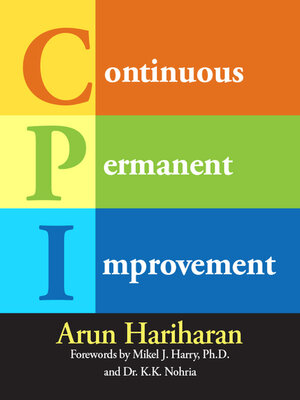
Sign up to save your library
With an OverDrive account, you can save your favorite libraries for at-a-glance information about availability. Find out more about OverDrive accounts.
Find this title in Libby, the library reading app by OverDrive.



Search for a digital library with this title
Title found at these libraries:
| Library Name | Distance |
|---|---|
| Loading... |
Forewords by Mikel J. Harry, Ph.D. and Dr. K.K. Nohria Continuous permanent improvement (CPI) is not a new ism. The purpose of this book is not to expound any new theory or tools, but to share experiences in implementing existing methods with a bias toward business results. In fact, one of the important lessons we have learned is that most existing models or methods, if adhered to in the right spirit, will give results. This book is a distillation of experiences and lessons learned from successes and mistakes in nearly three decades of experience, mostly working with business processes, systematic thinking, customer focus, quality, and performance measurements—in a variety of companies and industries as diverse as financial services, telecom, manufacturing, conglomerate, and management consulting. Not being about any specific companies or industries, the contents of this book can be applied in any industry—service or manufacturing or government or education or nonprofit. The target audience of this book is business, functional, and quality leaders. Business schools and students may also use it as a text or reference book for courses on business excellence or quality. It is intended to share the experience and results of organizations that have derived substantial and sustained business results by focusing on continuous permanent improvement. Its aim is to strengthen the belief of the reader in the strategic importance of CPI, because the stronger your belief, the bigger and more sustained will be your results. The book also covers challenges related to mind-sets and other change management aspects that leaders typically will need to grapple with. Some of the very effective improvement methods and tools are explained in simple language with real examples, with senior business leaders in mind.|Forewords by Mikel J. Harry, Ph.D. and Dr. K.K. Nohria Continuous permanent improvement (CPI) is not a new ism. The purpose of this book is not to expound any new theory or tools, but to share experiences in implementing existing methods with a bias toward business results. In fact, one of the important lessons we have learned is that most existing models or methods, if adhered to in the right spirit, will give results. This book is a distillation of experiences and lessons learned from successes and mistakes in nearly three decades of experience, mostly working with business processes, systematic thinking, customer focus, quality, and performance measurements—in a variety of companies and industries as diverse as financial services, telecom, manufacturing, conglomerate, and management consulting. Not being about any specific companies or industries, the contents of this book can be applied in any industry—service or manufacturing or government or education or nonprofit. The target audience of this book is business, functional, and quality leaders. Business schools and students may also use it as a text or reference book for courses on business excellence or quality. It is intended to share the experience and results of organizations that have derived substantial and sustained business results by focusing on continuous permanent improvement. Its aim is to strengthen the belief of the reader in the strategic importance of CPI, because the stronger your belief, the bigger and more sustained will be your results. The book also covers challenges related to mind-sets and other change management aspects that leaders typically will need to grapple with. Some of the very effective improvement methods and tools are explained in simple language with real examples, with senior business leaders in mind.







